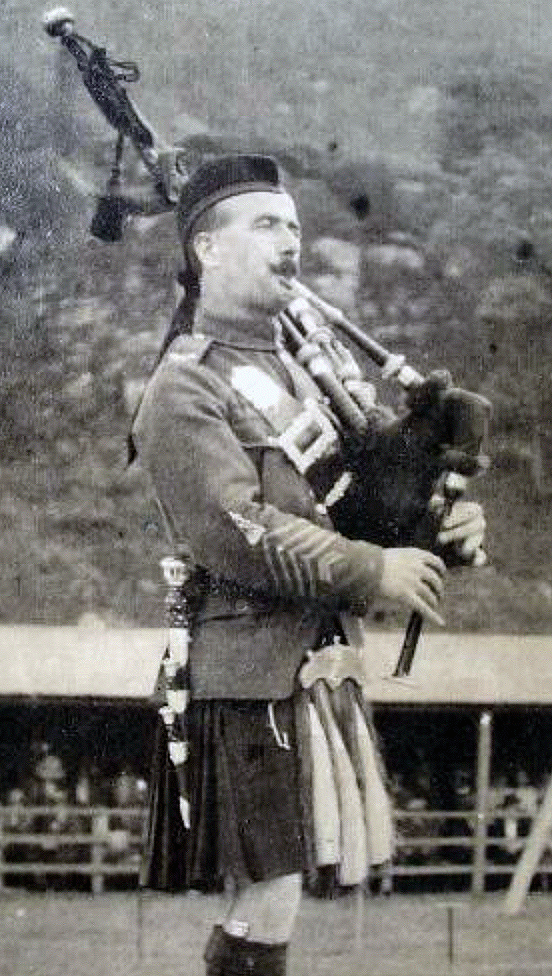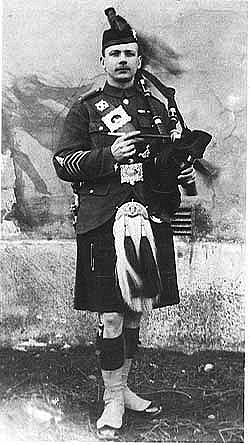Author Colin Campbell concluded the third, December 6th, 2014, concert in the ‘Pipes Tunes of WW1′ project with a detailed look at some seldom-played tunes associated with the Gordon Highlanders. The project is organised by the Scottish Pipers’ Association and funded by the National Lottery.
Between 1759 and 1793, the Duke of Gordon raised three regiments known as the Northern Fencibles or Gordons, which did good service before being stood down. The regiment that we honour here was formed in 1794 for the French Revolutionary Wars. Duchess Jane Gordon is reputed to have added her kiss to the guinea offered to potential recruits. Once established, the 100th Foot, the Gordons, served throughout the Revolutionary and Napoleonic Wars. Their unique black buttoned spats, perpetuated in the Royal Regiment of Scotland, are said to commemorate Gordons carrying Sir John Moore to his grave at Corunna. The foreword to 1/6th Gordons’ history reads: ‘What was the secret of their excellence? They were imbued with the highest regimental esprit de corps, they were proud of their Division; they considered themselves the best Battalion in the best Division, and they endeavoured to act up to that standard.’
1/6th Gordons teased novices: ‘Each saphead [a listening post, a shallow, narrow, often disguised position in No Man’s Land] in front of our line was held by a ‘double sentry’ – two men on duty for a spell of two hours – one seasoned veteran and a new hand from the English division. The officer on duty, going round the line, came upon two such men preparing to go to the saphead to relieve the sentries there and heard the following whispered conversation:
New Hand: ‘How far off are the Germans, Jock?’
Old Hand: ‘Files [sometimes], they’re a hunner yairds; files they’re fifty; bit man (with impressiveness) files they’re sa near that at nicht they’ll rach ower their han’ an’ tak aff yer bunnet.’
Tunes played by Army pipers Cpl James Muir, The Black Watch, Cpl Peter Grant, The Highlanders, Cpl Jason Bruce, Royal Scots Dragoon Guards and Cpl Charles MacLean Royal Highland Fusiliers:
The Cock o’ the North. Battalion regimental march. The nickname used for the chief of the Gordon clan.
The 92nd Quickstep. Marching off the Colours to the Officers’ Mess. The Gordon Highlanders were the 92nd Regiment.
The Marquis of Huntly. C Company. The title of the Chief of the Gordon clan. The fourth Duke was a Scottish Representative Peer from 1767 to 1784 and served as Lord Lieutenant of Aberdeenshire and as Keeper of the Great Seal of Scotland.
The Reel of Tulloch. Played after the second set in the Officers’ Mess. The dance was supposedly invented in a kirkyard when the minister was late owing to snow, and the congregation danced round the gravestones to keep warm.
A Man’s a Man for a’ That. Defaulters – Commanding Officer’s Orders. Robert Burns’ anthem in praise of the common man.
The Gordons’ March. Advance in review order, also played after the second set in the Officers’ Mess.
Tunes played by Robert Wallace:

Kitchener’s Army and Captain C.R.Lumsden. About 2.5 million volunteered, another 2.5 million were conscripted from January 1916, spourred ion by Kitchener’s famous poster. The tunes are by P/M George Stuart McLennan. He was born in 1883 in Edinburgh. He was a sickly child who did not walk until he was four and a half, but had already started piping by then! He joined the Gordons in 1899 and became P/M of the 1st Bt. in 1905. He served at the Gordons depot from 1913 – 1918, and though this suggests he was not fit enough to go overseas he did, in 1918, as a Lewis gunner. He may have volunteered, or have been combed out, as the army was desperate for reinforcements. Later, he fell ill with fluid in his left lung and was discharged in 1922. He began making pipes in Aberdeen and died in 1929. His compositions are considered among the finest of the 20th century.
Captain C.R.Lumsden was the son of Mr and Mrs W.H. Lumsden of Balmedie and had served in the South African War. He was killed in action on 26th August 1914 at the tail end of the Battle of Le Cateau – possibly near Audencourt, north-west of Le Cateau. The 1st Gordons almost ceased to exist by the end of the retreat from the preceding battle at Mons. Capt. Lumsden was aged 34 and unmarried. His name is inscribed on the La Ferte-sous-Jouarre Memorial.
Trooping the Colour. This is a slow march also by GS McLennan.
When the Boys Come Home Again and Colonel Horton, a 2/4 march, are by P/M William Mann. Mann was born in 1864 in Ellon, Aberdeenshire. He was P/M of the 1st Volunteer Battalion of the Gordons and then with the full regiment from 1904. During the war he was probably with 2/4th Gordons which then combined with 2/5th as reserve battalion as his obituary states he coached pipers from other units at Scone, Bedford and Norwich where these second line battalions were stationed. These tunes are in Logan’s War Memorial Collection of 1914-1918 tunes.

Major CM Usher OBE. Major Usher joined the Gordons in 1911. He was an enthusiastic amateur piper and was coached by G.S. McLennan, the composer. After Mons, in August 1914, he was imprisoned and organised a 13-strong pipe band. He was awarded the OBE for his leadership and later, in WW2, received the Distinguished Service Order (DSO) when in command of the Ist Gordons at Dunkirk.
Captain CM Usher’s Strathspey by P/M J Duff. The P/M was born in 1875, joined the Gordons in 1891, then to Argylls, then the Royal Scots in India and finally to the 2nd Bn Gordons during WW1. He was captured and interned in Holland in 1914 where he formed a pipe band from internees. He was on the first SPBA panel of judges in the 1930s.
Captain CM Usher’s Reel. The composer, James Robertson, Banff, served with the 1st Gordons, was tutored by GS McLennan, imprisoned after Mons, escaped three times and given the Meritorious Service Medal for his harassing of the Germans. He went back to 1st Gordons after the war.
Captain T. MacWhirter M.C. (9th Battalion, Gordon Highlanders) is a 6/8 march. The 9th Gordons were the Pioneer Battalion of the 15th (Scottish) Division. Composed by Piper McKay Tait during WW1, the tune is in The Pipes of War Collection
Major John McLennan, Gordon Highlanders, is the well-known 6/8 by G.S.McLennan. John McLennan was George McLennan’s cousin. John was injured when his horse shied at the sound of shellfire and subsequently died on 9th August 1916, aged 51. He is buried at Aberdeen (Springbank) Cemetery, reference P. 23.
[easyrotator]erc_55_1416493860[/easyrotator]The Unknown Warrior, a slow march by G.S. McLennan. Wikipedia: ‘The idea of a Tomb of the Unknown Warrior was first conceived in 1916 by the Reverend David Railton, who, while serving as an army chaplain on the Western Front, had seen a grave marked by a rough cross, which bore the pencil-written legend ‘An Unknown British Soldier’. He wrote to the Dean of Westminster in 1920 proposing that an unidentified British soldier from the battlefields in France be buried with due ceremony in Westminster Abbey ‘amongst the kings’ to represent the many hundreds of thousands of Empire dead.
‘Suitable remains were exhumed from various battlefields and brought to the chapel at Saint-Pol-sur-Ternoise near Arras, France. The remains were on stretchers each covered by Union Flags: two officers did not know from which battlefield any individual body had come. One, with closed eyes, rested his hand on one of the bodies. It was placed in a plain coffin and sealed. The other bodies were then taken away for reburial. It seems highly likely that the bodies were carefully selected and it is almost certain that the Unknown Warrior was a soldier serving in Britain’s pre-war regular army and not a sailor, airman, or Empire serviceman.
‘On the morning of 11 November 1920, a cortège was then followed by The King, the Royal Family and ministers of state to Westminster Abbey where the casket was borne into the West Nave of the Abbey flanked by a guard of honour of one hundred recipients of the Victoria Cross. The guests of honour included a group of about one hundred women. They had been chosen because they had each lost their husband and all their sons in the war. ‘Every woman so bereft who applied for a place got it’.
‘The grave was then capped with a black Belgian marble stone (the only tombstone in the Abbey on which it is forbidden to walk) featuring this inscription, composed by Herbert Edward Ryle, Dean of Westminster, and engraved with brass from melted down wartime ammunition:
OF A BRITISH WARRIOR
UNKNOWN BY NAME OR RANK
BROUGHT FROM FRANCE TO LIE AMONG
THE MOST ILLUSTRIOUS OF THE LAND
AND BURIED HERE ON ARMISTICE DAY
11 NOV: 1920, IN THE PRESENCE OF
HIS MAJESTY KING GEORGE V
HIS MINISTERS OF STATE
THE CHIEFS OF HIS FORCES
AND A VAST CONCOURSE OF THE NATION
* The fourth and fifth concerts in this very worthwhile SPA project will be held next year, the first in April at the College of Piping. Keep checking pipingpress.com for details. Admission free.















